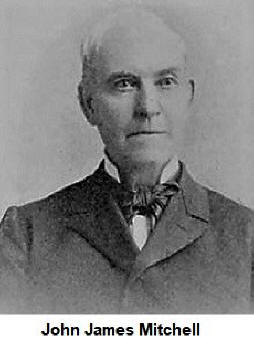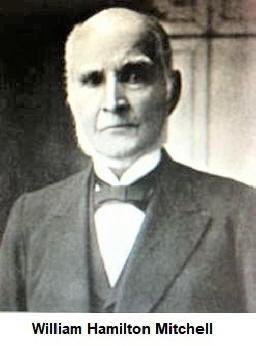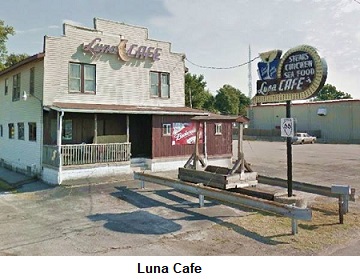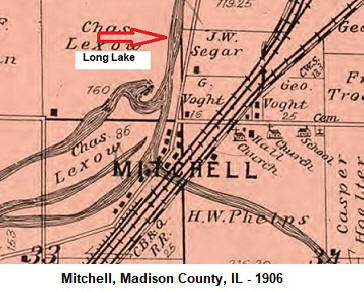Early History of Mitchell
Pre-historic Era
In pre-historic times, small pyramids dotted the landscape near the
future Mitchell Station in Chouteau Township. One pyramid was 300
feet on each of its four sides, 25 or 30 feet high. It was excavated
away to make room for railroad tracks. A great number of relics were
found showing that the mound was used as a burial site. There were
copper implements and ornaments, some made to represent the shell of
a tortoise. One relic was found covered with copper, that when
broken, it was discovered that the copper was spooled around bone.
Copper awls and needles were found – some 18 inches in length. There
were also flint implements and the teeth of a buffalo.
The American Bottoms
The future site of Mitchell Station (later called Mitchell) was part
of the American Bottoms. Rich soil and marshes provided good hunting
and farmland. Most of the early settlers in the Mitchell area were
hardworking German farmers. Andrew Emert, who immigrated from
Pennsylvania, settled in the future site of Mitchell in 1807.
Another settler was James Gillham, who came to Chouteau Township in
1794 in search of his wife and children, who had been taken captive
by Kickapoo Indians in 1790. A four-year search was made before the
family was reunited and settled near Long Lake. The first industry
of the area was a mill operated as early as 1820 by Moses Job. Job
opened the first store in 1839. As time went on, immigrants bought
the land and established their farms.
In 1813, the courts issued an order to establish the first two
county highways – one from Edwardsville to a bridge over Long Lake
in the neighborhood of Mitchell; the other from that bridge to the
Mississippi River, a short distance from the St. Louis Ferry.
John J. and William H. Mitchell
In 1870, John J. and William H. Mitchell purchased approximately
4,000 acres in the future site of Mitchell Station. They dreamed of
creating and operating a cattle ranch. The brothers had been
residents of Alton, owning a steam mill and distillery. They had
also been partners with Colonel Buckmaster in connection with the
Alton State Penitentiary. During the Civil War, they played a part
in bringing arms from St. Louis aboard their steamboat, to keep the
weaponry from falling into the hands of the Confederates. The
Mitchell brothers drained the swamplands and marshes on their lands
and built their ranch, with Michael Smith Link as foreman. In 1871,
John Mitchell backed the construction of an elevator in Venice.
Later, John J. moved to St. Louis, and William moved to Chicago.
Mitchell Station Established

By 1882, Mitchell Station had two general stores - one of which was
owned by Hinze & Krueger, and the other by Henry Reinamann. Henry
Quinn operated a blacksmith shop and kept a grocery store. A. Rapp
operated a meat market. The physician was D. E. Smalley,
In 1904, when the World’s Fair was held in St. Louis, the Illinois
Traction Street Car Line was built from St. Louis to Mitchell, and
in 1905 it was extended to Alton.
Sometime before 1920, Ernest A. Brooks of St. Louis established a
residential subdivision so that homes could be built for families of
railroad workers. However, a large building boom didn’t take place
until the 1950s and 1960s, when industrial workers from Granite
City, Madison, and Venice were looking for homes.
 U.
S. Route 66 ran through Mitchell, and various businesses along the
road became stops for travelers and truckers. One of these was the
Luna Café, built in 1924. It was rumored the café had illegal
gambling activities.
U.
S. Route 66 ran through Mitchell, and various businesses along the
road became stops for travelers and truckers. One of these was the
Luna Café, built in 1924. It was rumored the café had illegal
gambling activities.
Since Mitchell was never been incorporated as a village, there has
never been any local government officials. Mitchell residents,
however, have been willing to take responsibility to improve their
community. Donations made by businesses and a five-dollar
subscription fee from each homeowner resulted in the establishment
of the Mitchell Fire District. The first fire truck was a 1923
Seagraves pumper, and the fire station construction began in 1946.
Early Schools of Mitchell
The Mitchell Brothers donated land on which to build a one-room
public school. The school was constructed in 1871, with an
additional room being added in 1904, and yet another room added in
1937. In 1950 it was overcrowded and the building was torn down.
Work began immediately on a new schoolhouse for children from
kindergarten through 6th grade. Upper grades attended Granite City
schools.
Early Churches of Mitchell
The Mitchell brothers donated land for the construction of two
churches – Catholic and Protestant. The construction of St.
Elizabeth’s Church began in 1871, with the cornerstone being laid
October 01, 1871. Parishioners supplied the labor and materials for
the construction, and the church was named in honor of Elizabeth
Hackethal Ebling, who furnished food for the workers.
A Protestant Church was erected with the stipulation that the title
to the land would be awarded after the church operated for twelve
years by any one denomination. The church was first used by a
Baptist congregation, then by a Methodist group, and last by
Presbyterians, who stayed in the church and fulfilled the
twelve-year requirement.
